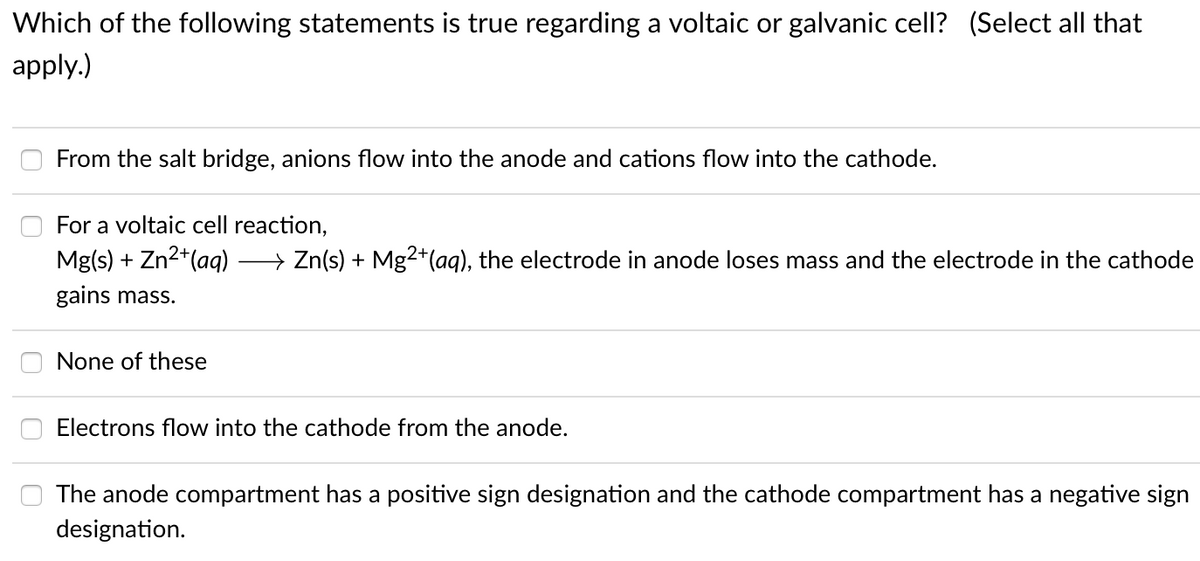Which of the following statements is true regarding a voltaic or galvanic cell? (Select all that apply.) From the salt bridge, anions flow into the anode and cations flow into the cathode. For a voltaic cell reaction, Mg(s) + Zn2*(aq) > Zn(s) + Mg2+(aq), the electrode in anode loses mass and the electrode in the cathode gains mass. None of these Electrons flow into the cathode from the anode. O The anode compartment has a positive sign designation and the cathode compartment has a negative sign designation.
Which of the following statements is true regarding a voltaic or galvanic cell? (Select all that apply.) From the salt bridge, anions flow into the anode and cations flow into the cathode. For a voltaic cell reaction, Mg(s) + Zn2*(aq) > Zn(s) + Mg2+(aq), the electrode in anode loses mass and the electrode in the cathode gains mass. None of these Electrons flow into the cathode from the anode. O The anode compartment has a positive sign designation and the cathode compartment has a negative sign designation.
Chemistry & Chemical Reactivity
9th Edition
ISBN:9781133949640
Author:John C. Kotz, Paul M. Treichel, John Townsend, David Treichel
Publisher:John C. Kotz, Paul M. Treichel, John Townsend, David Treichel
Chapter19: Principles Of Chemical Reactivity: Electron Transfer Reactions
Section: Chapter Questions
Problem 7PS: A voltaic cell is constructed using the reaction of chromium metal and iron(II) ions. 2 Cr(s) + 3...
Related questions
Question

Transcribed Image Text:Which of the following statements is true regarding a voltaic or galvanic cell? (Select all that
apply.)
From the salt bridge, anions flow into the anode and cations flow into the cathode.
For a voltaic cell reaction,
Mg(s) + Zn2*(aq)
→ Zn(s) + Mg²+(aq), the electrode in anode loses mass and the electrode in the cathode
gains mass.
None of these
Electrons flow into the cathode from the anode.
The anode compartment has a positive sign designation and the cathode compartment has a negative sign
designation.
Expert Solution
This question has been solved!
Explore an expertly crafted, step-by-step solution for a thorough understanding of key concepts.
This is a popular solution!
Trending now
This is a popular solution!
Step by step
Solved in 2 steps

Knowledge Booster
Learn more about
Need a deep-dive on the concept behind this application? Look no further. Learn more about this topic, chemistry and related others by exploring similar questions and additional content below.Recommended textbooks for you

Chemistry & Chemical Reactivity
Chemistry
ISBN:
9781133949640
Author:
John C. Kotz, Paul M. Treichel, John Townsend, David Treichel
Publisher:
Cengage Learning

Chemistry & Chemical Reactivity
Chemistry
ISBN:
9781337399074
Author:
John C. Kotz, Paul M. Treichel, John Townsend, David Treichel
Publisher:
Cengage Learning

Chemistry for Engineering Students
Chemistry
ISBN:
9781337398909
Author:
Lawrence S. Brown, Tom Holme
Publisher:
Cengage Learning

Chemistry & Chemical Reactivity
Chemistry
ISBN:
9781133949640
Author:
John C. Kotz, Paul M. Treichel, John Townsend, David Treichel
Publisher:
Cengage Learning

Chemistry & Chemical Reactivity
Chemistry
ISBN:
9781337399074
Author:
John C. Kotz, Paul M. Treichel, John Townsend, David Treichel
Publisher:
Cengage Learning

Chemistry for Engineering Students
Chemistry
ISBN:
9781337398909
Author:
Lawrence S. Brown, Tom Holme
Publisher:
Cengage Learning

Chemistry: Principles and Practice
Chemistry
ISBN:
9780534420123
Author:
Daniel L. Reger, Scott R. Goode, David W. Ball, Edward Mercer
Publisher:
Cengage Learning

Chemistry by OpenStax (2015-05-04)
Chemistry
ISBN:
9781938168390
Author:
Klaus Theopold, Richard H Langley, Paul Flowers, William R. Robinson, Mark Blaser
Publisher:
OpenStax

General Chemistry - Standalone book (MindTap Cour…
Chemistry
ISBN:
9781305580343
Author:
Steven D. Gammon, Ebbing, Darrell Ebbing, Steven D., Darrell; Gammon, Darrell Ebbing; Steven D. Gammon, Darrell D.; Gammon, Ebbing; Steven D. Gammon; Darrell
Publisher:
Cengage Learning